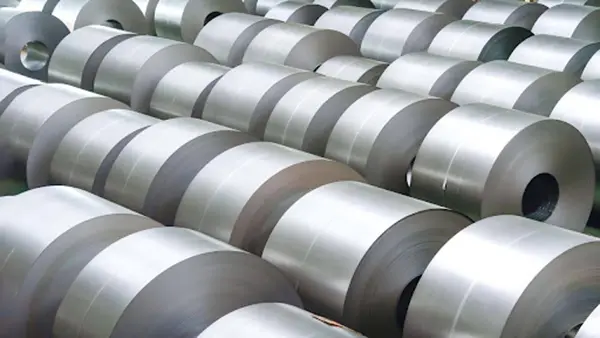Walk into a modern coil coating plant and the first thing you notice isn’t the noise, it’s the rhythm. Steel and aluminum coils move in a continuous flow, cleaned, coated, baked and rewound within minutes. Every meter is measured and every parameter logged.
Over the past years, I’ve seen a quiet transformation take place. Manufacturers who once often relied on manual spray booths or powder coating cabins now speak in the line speed, film thickness, gloss units and VOC recovery rate. Coil coating isn’t only faster, and it’s cleaner, more consistent and increasingly energy-efficient, thanks to its continuous closed-loop design that minimizes overspray and captures nearly all solvent emissions for treatment.
What still strikes me, even after years in this industry, is how coil coating quietly proves that high-volume manufacturing and environmental responsibility don’t have to conflict. It’s a mindset shift from the finishing parts to engineering performance. Today, coil coating defines the new industrial standard for continuous and closed-loop finishing. From facades and automotive trims to home appliance panels, this process delivers both aesthetic control and environmental accountability. That’s why more engineers or buyers now evaluate coating systems not by brand or color but by lifecycle data, like the durability, waste ratio and energy recovery.
Because at CoatingsDirectory, our goal is to make that choice easier. We connect coating buyers, engineers, and manufacturers with verified technologies, products, and services that match their real-world needs. So it’s written for people who want clarity before commitment – those making real decisions about production, procurement and technology alignment.
Why Choose Coil Coating Over Spray or Powder Coating?
| Factor | Coil Coating | Spray Coating | Powder Coating |
|---|---|---|---|
| Film uniformity | Continuous roll ensures even thickness and gloss | Operator-dependent and variable pattern | Thick build, often uneven edges |
| Material efficiency | ≈ 95 % paint transfer; overspray very low | 60-80 % transfer efficiency | Reclaim possible but contamination risk |
| Environmental impact | Closed-loop exhaust to oxidizer; VOC removal ≥ 95 % | High VOC unless water-borne | Low VOC but requires a large dust-control system |
| Production speed | Typically 80-150 m/min | Batch; slower cycle | Moderate; per-batch cure |
| Energy use | Heat-recovery curing can greatly reduce gas demand | High per part | Large ovens; complex reclaim |
How to Choose the Right Coil Coating?
Once you understand what makes coil coating superior, the next challenge begins, that is choosing the system that truly fits your project. I’ve seen even experienced buyers hesitate here. With so many chemistries, gloss levels and environmental requirements, the line between “good enough” and “over-specified” can be thin. The wrong choice doesn’t just affect appearance; it can also alter a product’s lifetime cost and reliability.
Choosing a coating is less about color charts and more about matching performance to purpose. Over the years, I’ve learned that five questions guide every successful selection, that is how long it needs to last, how much it will flex, how much it costs to maintain, how it complies with regulations and where it will live.
Durability and Weather Resistance
If your panels face rain, UV or salt spray, durability becomes very non-negotiable. Fluoropolymer systems like PVDF remain the gold standard, retaining gloss and color for up to 30 years even in coastal or high-UV zones. For moderate climates, silicone-modified polyester (SMP) offers a great balance between cost and endurance, while polyester (PE) fits interior or appliance use. I often remind my clients: “Don’t over-engineer for the weather you don’t have.” Just like a facade in Oslo doesn’t need the same chemistry as one in Singapore.
Adhesion and Formability
Good adhesion isn’t something you see, and it’s something you feel when the sheet bends. A coil-coated panel should flex with the metal, not crack against it. For deep-draw or roll-forming applications like refrigerator doors or HVAC casings, polyurethane (PU) and high-grade polyester perform best. Reliable suppliers can show T-bend (ASTM D4145) and cross-hatch results proving flexibility. So when I watch a panel pass a 0 T bend without fracture, I know the chemistry and curing are in the perfect harmony.
Cost and Lifecycle Value
Price is the easiest metric to compare and also the easiest to misread. The real cost hides in maintenance, warranty claims and downtime. I’ve seen many factories cut repainting budgets by half simply by moving from standard PE to SMP, not because SMP was cheaper, but because it lasted longer. So think in lifecycle terms, not just the unit price. A coating that performs five years longer doesn’t just save labor; it protects brand trust as well.
| Coating Type | Typical Use | Approx. Lifespan | Relative Cost Index * |
|---|---|---|---|
| Polyester (PE) | Indoor or short-term outdoor | 7-12 years | 1.0 |
| SMP | Mid-range exterior | 12-20 years | 1.3 |
| PVDF | Premium facade or roofing | 20-35 years | 1.8 |
| PU | High-touch or appliance | 10-18 years | 1.4 |
* Aactual pricing varies by region and substrate.
Regulatory and Environmental Compliance
Coatings don’t just protect metal, and they also protect reputations. Exporting to Europe or North America means meeting REACH, RoHS and local VOC limits. Increasingly, buyers also ask whether formulations are PFAS-free or ISO 14001 certified. The best suppliers answer these questions without hesitation because they’ve already invested in cleaner chemistries. When reviewing technical data sheets, I always look for transparency, cause it’s the surest sign of accountability.
End-Use Context and Application Fit
Finally, context decides everything. The same coil that performs flawlessly on a building facade might fail inside a food can. Every application has its own stress factors, like the mechanical, thermal or chemical. Matching chemistry to environment is half science and half empathy for how the product will live its life.
| Application | Recommended System | Key Advantage |
|---|---|---|
| Architectural facades or roofing | PVDF | Exceptional UV and color retention |
| Appliance panels | PE/PU | Smooth finish, high formability |
| Automotive trim or HVAC | SMP/PU | Chemical resistance and flexibility |
| Food-grade packaging | Epoxy/BPA-free | Safe barrier performance |
When I advise my clients, I often draw one simple conclusion, that is the best coating isn’t the most expensive or the newest, and it’s the one that fits. That quiet fit between chemistry, environment and purpose defines a truly smart selection. But choosing the right coating is only the first step. Once it’s on the line, quality control becomes the real test, for example, how well each batch holds up in thickness, gloss and adhesion. That’s where data meets craft and where the next step begins.
How to Check the Quality of Coil Coating?
No coating system earns trust until it’s tested. In coil coating, quality isn’t an afterthought, and it’s the heartbeat of the process. I’ve walked through lines where every meter of coated steel carries a record, like the line speed, bake temperature, viscosity and batch code. The best plants don’t just chase production targets; they would chase consistency. That’s what separates a good coil from a great one.

- Film Thickness.
The first thing I measure on any coil is the film thickness. It’s a very simple check, but it reveals how stable the process truly is. In a properly calibrated line, the primer sits around 4-6 µm and the topcoat 18-20 µm, confirmed by magnetic induction or eddy-current gauges (ISO 2360 or ASTM D7091). When readings drift more than ±1 µm across a sheet, I know the roll gap or coating pressure needs adjustment. Precision here isn’t vanity, but it’s the good signature of process control. - Appearance and Surface Uniformity.
After thickness, I turn to what my eyes see, such as the color, gloss and feel. A premium coil should show no orange peel, no pinholes and a consistent gloss within ±5 gloss units (ASTM D523). Many suppliers also track ΔE color variation (ASTM D2244), keeping it below 1-1.5 for architectural grades. Sometimes I run my fingers across the surface after curing, and I can feel when a line is well-tuned, just like smooth, clean and almost silky. Machines can measure, but touch tells the truth faster. - Adhesion and Flexibility.
Coil coatings live hard lives. They’re bent, stamped and stretched long after they leave the oven. I’ve seen perfect panels fail simply because curing ran 10 °C too low. The surest way to prove flexibility is through 3 key tests:
T-bend (ASTM D4145) – to check the cracking or peeling on tight folds.
Cross-hatch (ASTM D3359) – to test the adhesion under cut stress.
Reverse impact (ASTM D2794) – to confirm the resistance to deformation.
A coating that survives 0 T bending without cracks is a good sign of harmony between chemistry and cure. When I witness that, I know the line team respects the material as much as the output. - Corrosion and Weathering Resistance.
Durability can’t be guessed, and it must be proven. Laboratories simulate years of exposure before the coil ever meets the field. The salt-spray test (ASTM B117) exposes samples to saline mist for hundreds or even up to 1,000 hours. The humidity test (ISO 6270-1) checks for blistering under condensation, while accelerated weathering (ASTM G155) forecasts gloss and color retention under the UV and water cycles. When a supplier can show the independent third-party test reports, it’s not marketing, it’s integrity. I always tell the procurement teams that trust certified data, not adjectives. - Consistency, Documentation and Transparency.
Numbers matter, but honesty matters more. The most reliable suppliers record everything, such as the line speed, bake curve, viscosity, batch ID, and share quality certificates tied to ASTM or ISO test results. I’ve learned that transparency in QC reports predicts reliability in performance. When a partner hides their test sheets, I don’t question the data, and I will question the culture. So transparency isn’t paperwork and it’s proof of pride. - The Human Element.
No matter how automated a line becomes, people remain its conscience. I’ve met many technicians who tap the coil edge just to hear the cured tone, and they’re rarely wrong. They’ll notice a color drift before any spectrophotometer does. These instincts come only from experience, and they give life to the data. Great coil coating happens when automation meets intuition when every operator feels responsible for the gloss that leaves the line.
So checking quality is not just finding faults, and it is confirming harmony. When every test aligns, you will know the system is ready to deliver value, not just volume. But what exactly does that value look like in numbers? The next part explores how much coil coating really costs and why price often tells only half the story.
FAQs
What is the main advantage of coil coating over spray or powder coating?
The biggest advantage is process control. Coil coating applies paint to flat metal before shaping, so every square meter gets an even and factory-controlled finish, and no runs, missed spots or rework. The entire sequence happens continuously on one moving line (cleaning, pretreatment, priming, top-coating, curing, cooling). Compared with conventional spray or powder processes, it’s faster, cleaner and up to 30 % more material-efficient with lower VOC emissions and energy use.
How long does coil-coated metal last outdoors?
Typically most coil-coated panels last 20 years or more, and high-performance PVDF systems often reach 30-40 years in good conditions. Actual lifespan depends on resin type and environment:
- PVDF retains the color and gloss best in coastal or high-UV climates;
- SMP balances cost and durability for common exterior use;
- PE works well indoors or in the mild climates.
Regular cleaning and preventing mechanical damage help extend service life well.

